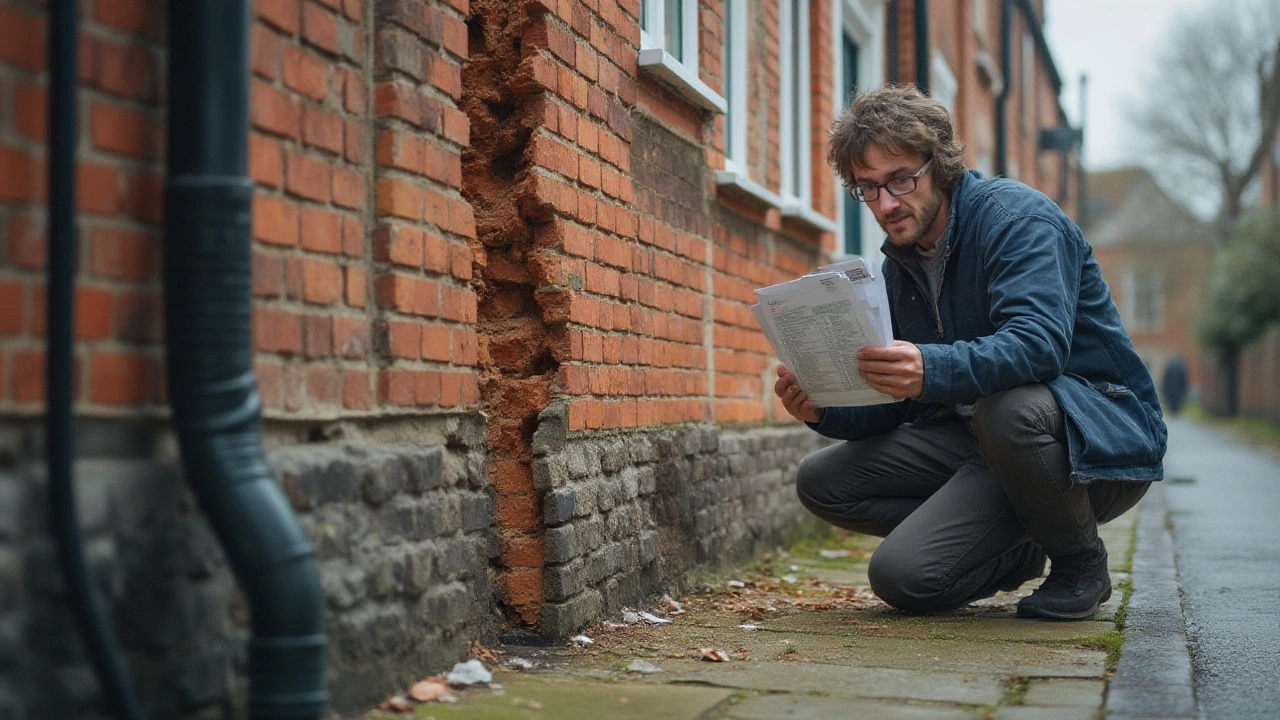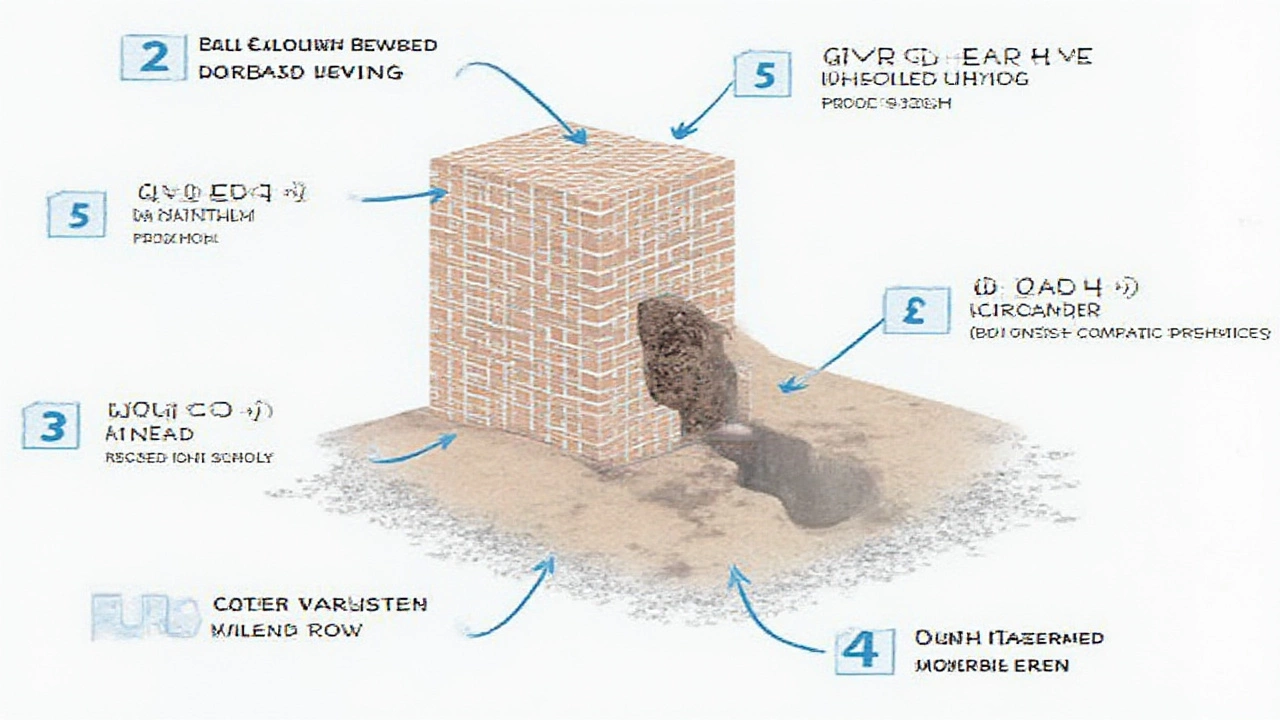Horizontal Foundation Crack Repair Cost: What Homeowners Need to Know
 Jul, 11 2025
Jul, 11 2025
Horizontal foundation cracks are basically the big red flags of the structural world. I remember the first time I saw a horizontal crack along the concrete wall in our basement; Rufus trotted past it like nothing was wrong, but I felt my stomach drop. Most people picture minor, harmless cracks running vertically like lines in an old map. But horizontal cracks? They’re a signal you cannot ignore. They can mean your foundation’s under serious pressure, usually from water-laden soil pushing against the outside walls or even from poor drainage around your house. So, ignoring them is not an option—unless you like the idea of your foundation slowly giving up the ghost.
Why Horizontal Cracks Are Different
Lots of folks see a crack in their basement wall and shrug it off. “Concrete settles,” they say. That might be true for some vertical cracks, but horizontal foundation cracks are a whole different ballgame. Here’s the thing: a horizontal crack usually means the pressure from outside soils is pushing the wall inward, and if it gets worse, you’re flirting with a full-blown wall collapse. No joke. In fact, estimates from the American Society of Civil Engineers show that poor soil and water around the home’s foundation account for up to 80% of structural problems. Now, compare a thin vertical crack, which often just needs cosmetic fixes, to a horizontal crack. Those horizontal lines aren’t just about appearances; they can be early warning signs of structural failure, so ignoring them would be reckless.
What causes this stress? Heavy clay soils that hold water, poor drainage, or even tree roots pressing relentlessly from years of growth. Living with Natalie, I’ve had plenty of time to learn (the hard way) that landscaping matters more to your basement than you’d think. When the water can’t drain away, it adds thousands of pounds of pressure per square foot. Combine that with the natural settling of nearly all homes, and you’ve got the perfect storm for disaster. So, if you do spot a horizontal crack wider than a quarter inch, it’s a clear sign you need to act fast. Beyond just the visible crack, moisture might sneak into your basement, causing mold and ruining indoor air quality.
Here’s a fun fact: Homeowners insurance rarely covers damage caused by settling and groundwater issues. Meaning, if you wait too long, you’ll be on the hook for the repairs. Since horizontal cracks signal structural risk, you want a professional assessment—not just a guy from the internet with a caulking gun. Foundation experts use a variety of tools to measure wall movement, examine outside grading, and check for moisture or even insects tunneling their way inside. The larger the crack, the bigger the potential fix. If the wall is bowing by more than two inches, brace yourself for even higher costs down the line.

The Real Costs: Breaking Down the Numbers
Let’s cut to the chase—how much does it really cost to repair a horizontal foundation crack? I remember getting quotes and feeling dizzy; there’s no “one size fits all” price tag. The cost can swing from a few hundred to tens of thousands of dollars, depending on severity, length, and your location. Here’s what you need to consider:
- Size and severity: Small cracks (1/4 inch or less, with no wall bowing) might run $500–$1,500 for simple epoxy injections.
- Moderate cracks: Horizontal cracks showing some inward bowing (up to 2 inches) may require carbon fiber reinforcement, usually costing $1,500–$3,500 per wall.
- Major structural damage: If your wall is bowing or leaning, you may need steel I-beams, wall anchors, or even total wall replacement—think $5,000–$15,000 or more.
These prices don't include fixing underlying drainage issues, which might add another $2,000–$5,000, or addressing soil grade problems outside your home. I’ve seen folks pay less up front just to cough up more cash in six months when the problem gets worse.
For a quick, real-world snapshot, here’s a table of average costs for different repair methods as of summer 2025:
| Repair Method | Estimated Cost (per wall) | Best Application |
|---|---|---|
| Epoxy/Polyurethane Injection | $500–$1,500 | Small, non-structural cracks |
| Carbon Fiber Straps | $1,500–$3,500 | Minor-moderate bowing |
| Steel I-Beams | $2,000–$6,000 | Moderate-severe bowing |
| Wall Anchors | $3,000–$8,000 | Severe bowing, lateral pressure |
| Full Wall Replacement | $10,000–$30,000 | Total failure, extreme cases |
If your home is older, or if you have finished basements, expect prices to skew higher because repair crews need more time and delicacy to do the job right. And don’t forget the wild card: location. Foundation work in New York often costs more than in Minnesota, thanks to higher labor rates and tougher building codes. If you notice water pooling along the outside walls (a classic sign you should not ignore), it’s time to deal with your gutters, downspouts, and exterior grading.
Also, be wary of anyone offering a “quick fix.” A proper repair almost always includes solving the root problem—outside water. The most reputable pros will recommend underground drainage tiles, a sump pump, or at least a proper swale or French drain outside. If water finds its way back, you might as well throw your money down the drain.

Tips, Red Flags, and Making the Smart Call
You want to avoid two things: overpaying for unnecessary repairs, and underestimating the problem, only to watch it get much more expensive. I’ve learned (after a few too many visits from the repair guys) that it’s all about catching issues early and avoiding panic buys. Here are some practical tips that have kept our basement drier—and our expenses lower—than they would have been:
- Don’t ignore drainage: Clean your gutters, extend downspouts at least ten feet away from the house, and make sure soil is sloping away. That ounce of prevention will save you a ton on repairs.
- Know your local soil: If you live in the Midwest or anywhere with expansive clay, monitor the soil around your foundation—especially after big storms or extended droughts.
- Watch for repeat moisture: Damp, musty smells or efflorescence (white powdery deposits on walls) are signs water keeps sneaking in. Fixing the crack without stopping the moisture means repairs won’t last.
- Get multiple quotes: Prices vary, and so do repair recommendations. Never trust a single opinion, especially if they push a specific product too hard.
- Check credentials: Look for foundation companies with local experience and solid reviews. Ask about warranties, and make sure you get everything in writing.
If you’re a DIY enthusiast, it’s tempting to give crack repairs a shot. You can buy epoxy injection kits for smaller, horizontal foundation crack issues, but these are best left for narrow, non-structural lines. Anything bigger than you can easily cover with your finger? Step away and call a professional. Trust me, even if Rufus thinks you’re handy, it’s not worth risking the stability of your whole house.
Something that caught my eye recently—a recent survey by HomeAdvisor (published late 2024) showed that homeowners spent an average of $4,946 in foundation repairs last year, but those who addressed cracks immediately paid 40% less than people who waited six months or more. There’s no reward in procrastinating with this type of damage.
Ever thought about selling your house? Home inspectors spot horizontal cracks right away, and buyers get spooked. You’ll either have to fix it before selling, or take a big cut on your sale price. It’s a harsh truth, but ignoring a foundation problem is one of the fastest ways to tank your home’s value.
Look out for the invisible stuff, too—mold loves damp basements. I used to think a musty smell was just part of having a finished basement, but Natalie convinced me to get an air-quality test. Mold spores hiding in dark corners aren’t just gross—they actually affect your lungs and can mess up your whole day. If moisture is seeping through that crack, you’ve got a double whammy to deal with.
If you’ve read this far, you probably know you can’t ignore a horizontal crack. Whether you’re facing minor repairs or major redos, staying proactive about inspection and repairs is the smartest move you can make. Your house, your air, and even your wallet will thank you in the long run.
